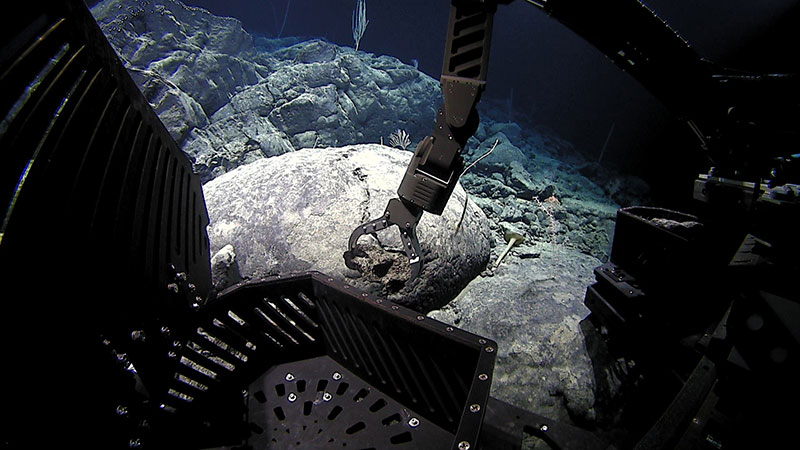
D2 collects a rock on an unnamed seamount 180 nautical miles south of Midway Island. Image courtesy of the NOAA Office of Ocean Exploration and Research, 2016 Hohonu Moana. Download larger version (jpg, 737 KB).

D2 collects a rock on an unnamed seamount 180 nautical miles south of Midway Island. Image courtesy of the NOAA Office of Ocean Exploration and Research, 2016 Hohonu Moana. Download larger version (jpg, 737 KB).
Dive 8: March 11, 2016
A featherstar, or unstalked, crinoid that was found attached to a coral during Dive 8. A discussion ensues around unbranched corals that are sometimes branched and whether crinoids or other animals could facilitate that by disturbing the coral's tissue and making room for other corals to grow. Video courtesy of the NOAA Office of Ocean Exploration and Research, 2016 Hohonu Moana. Download larger version (mp4, 114.0 MB).
Dive 8 was on a ridge located on the top portion of an unnamed seamount. The seamount is located ~200 miles south of Midway and was chosen as the last dive site of this expedition due to its geographic position and transit considerations to Kwajalein Atoll. The seamount was only mapped during this expedition and had therefore never been previously surveyed. The remotely operated vehicle (ROV) landed on the ridge crest at a depth of 3,994 meters. The substrate consisted of rounded cobble to boulder talus with little to no sediment and cemented by Mn crust. The bottom substrate was inhabited by a moderate density of sponges and corals. A moderate current was observed from the east towards the west. As the ROV moved up along the ridge crest, the density of corals remained moderate. Further up the slope, the ROV collected a coral specimen of Chrysogorgia that no one could identify. This species was relatively common throughout the dive. Along this portion of the dive track were channels incised in to the seafloor with light sediment concentrations and smaller cobble-pebble aggregations suggestive of downslope transport via these structures. As the ROV continued to move up the slope, the density of benthic animals remained moderately high. At 3,915 meters, the ROV collected a sample of a bamboo coral. Towards the end of the dive, the ROV moved towards and over the steep southern flank of the ridge crest that was constructed of pillow lava structures with no obvious layering. Here, the substrate was covered by a high density of barnacles, but sponges and corals were less abundant than on the ridge crest. The ROV left the bottom at a depth of 3,924 meters. Sadly, this was the last dive of the cruise, so once the ROV was on deck, we commenced transiting to the Marshall Islands.